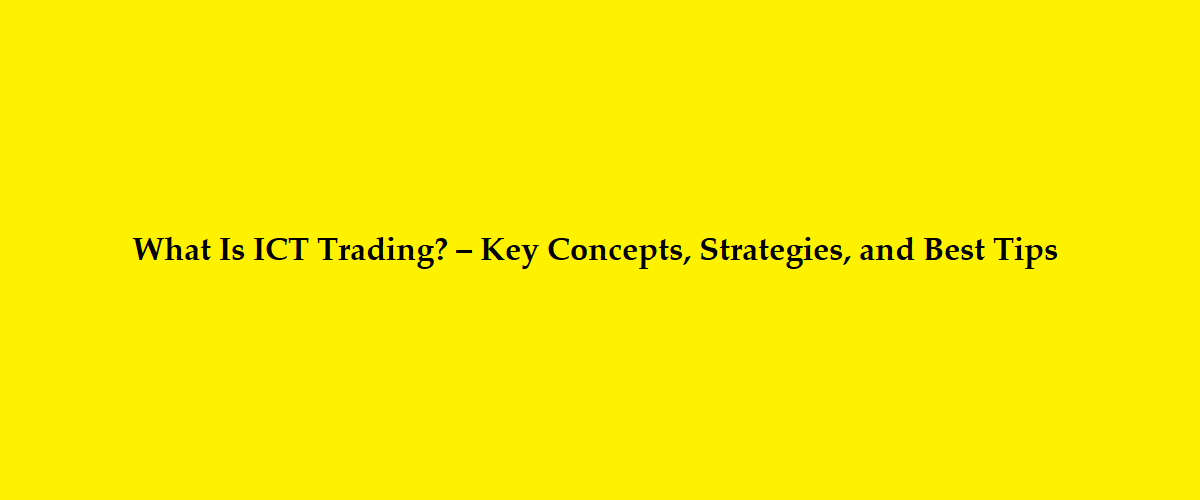Discover what ICT trading is, its key concepts, and expert tips for success. Learn the best strategies and tools to enhance your trading performance.
In the fast-paced world of financial markets, traders are always looking for innovative strategies to gain an edge. One such approach that has gained significant popularity is ICT (Inner Circle Trader) trading. Developed by Michael Huddleston, ICT trading focuses on understanding market structure, liquidity, and institutional order flow to make informed trading decisions.
Whether you’re a beginner or an experienced trader, mastering ICT trading concepts can significantly improve your profitability. In this comprehensive guide, we’ll break down what ICT trading is, its key concepts, top features to look for, and actionable tips to help you succeed.
What Is ICT Trading?
ICT trading is a methodology that emphasizes price action, market structure, and institutional trading behaviors. Unlike traditional retail trading strategies, ICT trading focuses on how large financial institutions (like banks and hedge funds) move the markets.
The core idea is to identify key levels where institutions are likely to place orders and trade alongside them. This approach helps traders avoid common pitfalls like false breakouts and emotional decision-making.
Key Principles of ICT Trading
- Market Structure (MSS) – Identifying trends, highs, lows, and key support/resistance levels.
- Order Blocks (OB) – Zones where institutions have placed large buy/sell orders.
- Liquidity Pools – Areas where stop losses are clustered, often targeted by big players.
- Fair Value Gaps (FVG) – Imbalances in price that create trading opportunities.
- Time & Price – Aligning trades with optimal times (e.g., London & New York sessions).
Top Features to Look for in ICT Trading
To effectively apply ICT trading strategies, you need the right tools and understanding. Here are the key features to consider:
1. Advanced Charting Tools
- Ability to identify order blocks, FVGs, and liquidity zones.
- Custom indicators for market structure breaks (MSB).
2. Real-Time Market Data
- Access to depth of market (DOM) and volume profile analysis.
- Reliable forex and stock market data feeds.
3. Institutional-Grade Analysis
- Tools to track smart money movements.
- Liquidity detection algorithms.
4. Risk Management Features
- Stop-loss and take-profit automation.
- Position sizing calculators.
5. Educational Resources
- Access to ICT mentorship content.
- Backtesting capabilities for strategy validation.
Best Picks for ICT Trading
To maximize your ICT trading success, consider these top tools and platforms:
1. TradingView
- Best for charting and drawing ICT concepts (order blocks, FVGs).
- Offers custom scripts for ICT strategies.
2. MetaTrader 4/5 (MT4/MT5)
- Supports automated trading with ICT-based algorithms.
- Large community of ICT traders sharing indicators.
3. NinjaTrader
- Advanced order flow analysis.
- Great for futures traders using ICT methods.
4. Bookmap
- Visualizes liquidity and institutional order flow.
- Helps spot market manipulation patterns.
5. ICT’s Private Discord & YouTube
- Direct insights from Michael Huddleston.
- Free and premium educational content.
5 Essential ICT Trading Tips for Success
1. Master Market Structure First
- Learn to identify higher highs (HH), lower lows (LL), and break of structure (BOS).
- Trade only when the trend confirms institutional moves.
2. Trade During Optimal Times
- Focus on London (3 AM – 12 PM EST) and New York (8 AM – 5 PM EST) sessions.
- Avoid low-liquidity periods (e.g., Asian session for forex).
3. Use Multiple Time Frame Analysis (MTF)
- Check higher time frames (HTF) for bias (daily, 4H).
- Execute entries on lower time frames (LTF) (15M, 5M).
4. Wait for Confirmation Before Entering
- Look for FVG fills, liquidity sweeps, and order block reactions.
- Avoid blindly entering trades without institutional confirmation.
5. Strict Risk Management
- Never risk more than 1-2% per trade.
- Use stop losses based on recent swing points.
FAQs About ICT Trading
1. Is ICT trading suitable for beginners?
Yes, but beginners should start with basic price action and market structure before diving into advanced ICT concepts.
2. What markets can I trade with ICT strategies?
ICT works best in forex, futures, and indices where institutional liquidity is high.
3. Do I need expensive software for ICT trading?
No, TradingView and MT4/MT5 offer free tools to apply ICT methods effectively.
4. How long does it take to master ICT trading?
It varies, but 6-12 months of consistent practice is typical for proficiency.
5. Can ICT trading be automated?
Partially—some concepts (like order blocks) can be coded, but discretionary analysis is often needed.

1 thought on “What Is ICT Trading? – Key Concepts, Strategies, and Best Tips”